Water Limitation in Forest Soils Regulates the Increase in Weathering Rates under Climate Change
Abstract
:1. Introduction
2. Materials and Methods
2.1. The ForSAFE Model
2.2. Study Area
2.3. Forest Sites Data
2.4. Climate
3. Results
3.1. Annual Weathering Rates
3.2. Annual Change in Weathering Following Climate Change
3.3. Change in Weathering during the Summer Season
3.4. Change in Weathering during the Winter Season
4. Discussion
5. Conclusions
Author Contributions
Funding
Institutional Review Board Statement
Informed Consent Statement
Data Availability Statement
Acknowledgments
Conflicts of Interest
References
- Steffen, W.; Richardson, K.; Rockström, J.; Cornell, S.E.; Fetzer, I.; Bennett, E.M.; Biggs, R.; Carpenter, S.R.; de Vries, W.; de Wit, C.A.; et al. Planetary boundaries: Guiding human development on a changing planet. Science 2015, 347. [Google Scholar] [CrossRef] [PubMed] [Green Version]
- IPCC. Climate Change 2014: Synthesis Report. Contribution of Working Groups I, II and III to the Fifth Assessment Report of the Intergovernmental Panel on Climate Change; Core Writing Team, Pachauri, R.K., Meyer, L.A., Eds.; IPCC: Geneva, Switzerland, 2014; 151p. [Google Scholar]
- Bennich, T.; Belyazid, S. The route to Sustainability-Prospects and challenges of the bio-based economy. Sustainability 2017, 9, 887. [Google Scholar] [CrossRef] [Green Version]
- FORMAS: The Swedish Research Council for Environment, Agricultural Sciences and Spatial Planning. Swedish Research and Innovation Strategy for a Bio-Based Economy; Report number R3:2012; FORMAS: Stockholm, Sweden, 2012; ISBN 978-91-540-6068-9. [Google Scholar]
- Lundmark, T.; Bergh, J.; Hofer, P.; Lundström, A.; Nordin, A.; Poudel, B.C.; Sathre, R.; Taverna, R.; Werner, F. Potential roles of Swedish forestry in the context of climate change mitigation. Forests 2014, 5, 557–578. [Google Scholar] [CrossRef]
- Börjesson, P.; Hansson, J.; Berndes, G. Future demand for forest-based biomass for energy purposes in Sweden. For. Ecol. Manag. 2017, 383, 17–26. [Google Scholar] [CrossRef]
- Cintas, O.; Berndes, G.; Hansson, J.; Poudel, B.C.; Bergh, J.; Börjesson, P.; Egnell, G.; Lundmark, T.; Nordin, A. The potential role of forest management in Swedish scenarios towards climate neutrality by mid century. For. Ecol. Manag. 2017, 383, 73–84. [Google Scholar] [CrossRef]
- De Jong, J.; Akselsson, C.; Egnell, G.; Löfgren, S.; Olsson, B.A. Realizing the energy potential of forest biomass in Sweden—How much is environmentally sustainable? For. Ecol. Manag. 2017, 383, 3–16. [Google Scholar] [CrossRef] [Green Version]
- Schöpp, W.; Posch, M.; Mylona, S.; Johansson, M. Long-term development of acid deposition (1880–2030) in sensitive freshwater regions in Europe. Hydrol. Earth Syst. Sci. 2003, 7, 436–446. [Google Scholar] [CrossRef] [Green Version]
- Warfvinge, P.; Bertills, U. Recovery from Acidification in the Natural Environment—Present Knowledge and Future Scenarios; Swedish Environmental Protection Agency: Stockholm, Sweden, 1999. [Google Scholar]
- Iwald, J.; Löfgren, S.; Stendahl, J.; Karltun, E. Acidifying effect of removal of tree stumps and logging residues as compared to atmospheric deposition. For. Ecol. Manag. 2013, 290, 49–58. [Google Scholar] [CrossRef]
- Akselsson, C.; Hultberg, H.; Karlsson, P.E.; Pihl Karlsson, G.; Hellsten, S. Acidification trends in south Swedish forest soils 1986–2008: Slow recovery and high sensitivity to sea- salt episodes. Sci. Total Environ. 2013, 444, 271–287. [Google Scholar] [CrossRef] [Green Version]
- Pihl Karlsson, G.; Akselsson, C.; Hellsten, S.; Karlsson, P.E. Reduced European emissions of S and N: Effects on air concentrations, deposition and soil water chemistry in Swedish forests. Environ. Pollut. 2011, 159, 3571–3582. [Google Scholar] [CrossRef] [Green Version]
- Belyazid, S.; Westling, O.; Sverdrup, H. Modelling changes in forest soil chemistry at 16 Swedish coniferous forest sites following deposition reduction. Environ. Pollut. 2006, 144, 596–609. [Google Scholar] [CrossRef] [PubMed]
- Akselsson, C.; Belyazid, S. Critical biomass harvesting—Applying a new concept for Swedish forest soils. For. Ecol. Manag. 2018, 409, 67–73. [Google Scholar] [CrossRef] [Green Version]
- Zetterberg, T.; Olsson, B.A.; Löfgren, S.; von Brömssen, C.; Brandtberg, P.O. The effect of harvest intensity on long-term calcium dynamics in soil and soil solution at three coniferous sites in Sweden. For. Ecol. Manag. 2013, 302, 280–294. [Google Scholar] [CrossRef]
- Claesson, S. Skogliga Konsekvensanalyser 2008 -SKA-VB 08; Rapport 25; Skogsstyrelsen: Jönköping, Sweden, 2008. (In Swedish) [Google Scholar]
- Akselsson, C.; Westling, O.; Sverdrup, H.; Holmqvist, J.; Thelin, G.; Uggla, E.; Malm, G. Impact of harvest intensity on long-term base cation budgets in Swedish forest soils. Water Air Soil Pollut. Focus 2007, 7, 201–210. [Google Scholar] [CrossRef]
- Akselsson, C.; Olsson, J.; Belyazid, S.; Capell, R. Can increased weathering rates due to future warming compensate for base cation losses following whole-tree harvesting in spruce forests? Biogeochemistry 2016, 128, 89–105. [Google Scholar] [CrossRef] [Green Version]
- Aherne, J.; Posch, M.; Forsius, M.; Lehtonen, A.; Härkönen, K. Impact of forest biomass removal on soil nutrient status under climate change: A catchment-based modelling study for Finland. Biogeochemistry 2012, 107, 471. [Google Scholar] [CrossRef]
- Oelkers, E.H.; Schott, J. An experimental study of enstatite dissolution rates as a function of pH, temperature, and aqueous Mg and Si concentration, and the mechanism of pyroxene/pyroxenoid dissolution. Geochim. Et Cosmochim. Acta 2001, 65, 1219–1231. [Google Scholar] [CrossRef]
- Sverdrup, H.; Warfvinge, P. Calculating field weathering rates using a mechanistic geochemical model profile. Appl. Geochem. 1993, 8, 273–283. [Google Scholar] [CrossRef]
- Eiriksdottir, E.S.; Gislason, S.R.; Oelkers, E.H. Does temperature or runoff control the feedback between chemical denudation and climate? Insights from NE Iceland. Geochim. Et Cosmochim. Acta 2013, 107, 65–81. [Google Scholar] [CrossRef]
- Goddéris, Y.; François, L.M.; Probst, A.; Schott, J.; Moncoulon, D.; Labat, D.; Viville, D. Modelling weathering processes at the catchment scale: The WITCH numerical model. Geochim. Et Cosmochim. Acta 2006, 70, 1128–1147. [Google Scholar] [CrossRef] [Green Version]
- Godderis, Y.; Brantley, S.L.; Francois, L.M.; Schott, J.; Pollard, D.; Deque, M.; Dury, M. Rates of consumption of atmospheric CO2 through the weathering of loess during the next 100 yr of climate change. Biogeosciences 2013, 10, 135–148. [Google Scholar] [CrossRef] [Green Version]
- Banwart, S.A.; Berg, A.; Beerling, D.J. Process-based modeling of silicate mineral weathering responses to increasing atmospheric CO2 and climate change. Glob. Biogeochem. Cycles 2009, 23, 1–13. [Google Scholar] [CrossRef]
- Erlandsson, M.; Oelkers, E.H.; Bishop, K.; Sverdrup, H.; Belyazid, S.; Ledesma, J.L.J.; Kähler, S.J. Spatial and temporal variations of base cation release from chemical weathering on a hillslope scale. Chem. Geol. 2016, 441, 1–13. [Google Scholar] [CrossRef] [Green Version]
- Palandri, J.L.; Kharaka, Y.K. A Compilation of Rate Parameters of Water-mineral Interaction Kinetics for Application to Geochemical Modeling; Geological Survey: Menlo Park, CA, USA, 2004. [Google Scholar]
- Oelkers, E.H.; Schott, J.; Devidal, J.L. The effect of aluminum, pH, and chemical affinity on the rates of aluminosilicate dissolution reactions. Geochim. Et Cosmochim. Acta 1994, 58, 2011–2024. [Google Scholar] [CrossRef]
- Wallman, P.; Svensson, M.; Sverdrup, H.; Belyazid, S. ForSAFE—An integrated process-oriented forest model for long-term sustainability assessments. For. Ecol. Manag. 2005, 207, 19–36. [Google Scholar] [CrossRef]
- Zanchi, G.; Belyazid, S.; Akselsson, C.; Yu, L. Modelling the effects of management intensification on multiple forest services: A Swedish case study. Ecol. Model. 2014, 284, 48–59. [Google Scholar] [CrossRef] [Green Version]
- Belyazid, S.; Phelan, J.; Nihlgård, B.; Sverdrup, H.; Driscoll, C.; Fernandez, I.; Aherne, J.; Teeling-Adams, L.; Arsenault, M.; Cleavitt, N.; et al. Assessing the Effects of Climate Change and Air Pollution on Soil Properties and Plant Diversity in Northeastern, U.S. hardwood forests: Model Setup and Evaluation. Water Air Soil Pollut. 2019, 230, 106. [Google Scholar] [CrossRef] [Green Version]
- Yu, L.; Zanchi, G.; Akselsson, C.; Wallander, H.; Belyazid, S. Modelling the forest phosphorus nutrition in a southwestern Swedish forest site. Ecol. Model. 2018, 369, 88–100. [Google Scholar] [CrossRef] [Green Version]
- Phelan, J.; Belyazid, S.; Kurz, D.; Guthrie, S.; Cajka, J.; Sverdrup, H.; Waite, R. Estimation of soil base cation weathering rates with the PROFILE model to determine critical loads of acidity for forested ecosystems in Pennsylvania, USA: Pilot Application of a Potential National Methodology. Water Air Soil Pollut. 2014, 225, 2109–2128. [Google Scholar] [CrossRef]
- Belyazid, S.; Zanchi, G. Water limitation can negate the effect of higher temperatures on carbon sequestration. Eur. J. For. Res. 2019, 138, 287–297. [Google Scholar] [CrossRef] [Green Version]
- Warfvinge, P.; Sverdrup, H. Calculating critical loads of acid deposition with PROFILE—A steady-state soil chemistry model. Water Air Soil Pollut. 1992, 63, 119–143. [Google Scholar] [CrossRef]
- Alveteg, M. Projecting Regional Patterns of Future Soil Chemistry Status in Swedish Forests using SAFE. Water Air Soil Pollut. Focus 2004, 4, 49–59. [Google Scholar] [CrossRef]
- Hägglund, B. En ny Svensk Riksskogstaxering (A New Swedish National Forest Survey); Report 37; Swedish University of Agricultural Sciences: Uppsala, Sweden, 1985; (In Swedish with English Summary). [Google Scholar]
- Akselsson, C. Regional Nutrient Budgets in Forest Soils in a Policy Perspective. Ph.D. Thesis, Department of Chemical Engineering, Lund University, Lund, Sweden, 2005. [Google Scholar]
- Simpson, D.; Benedictow, A.; Berge, H.; Bergström, R.; Emberson, L.D.; Fagerli, H.; Flechard, C.R.; Hayman, G.D.; Gauss, M.; Jonson, J.E.; et al. The EMEP MSC-W chemical transport model—Technical description. Atmos. Chem. Phys. 2012, 12, 7825–7865. [Google Scholar] [CrossRef] [Green Version]
- Persson, C.; Langner, J.; Robertson, L. Air pollution assessment studies for Sweden based on the match model and air pollution measurements. In Air Pollution Modeling and Its Application XI; Gryning, S.E., Schiermeier, F.A., Eds.; Springer: Boston, MA, USA, 1996; pp. 127–134. [Google Scholar]
- Swedish Forest Agency. Gallringsmallar—Södra Sverige; Skogsstyrelsen: Jönköping, Sweden, 1985. [Google Scholar]
- Swedish Forest Agency. Gallringsmallar—Norra Sverige; Skogsstyrelsen: Jönköping, Sweden, 1985. [Google Scholar]
- Jacobson, S.; Sikström, U.; Nyström, K.; Övergaard, B. INGVAR—Thinning Schedules and Forest Management Planning Tool; SkogForsk: Uppsala, Sweden, 2008; (In Swedish with English Summary). [Google Scholar]
- Rayner, D.; (Gothenburg University, Gothenburg, Sweden). Personal communication, 2010.
- Akselsson, C.; Belyazid, S.; Stendahl, J.; Finlay, R.; Olsson, B.A.; Erlandsson Lampa, M.; Wallander, H.; Gustafsson, J.P.; Bishop, K. Weathering rates in Swedish forest soils. Biogeosciences 2019, 16, 4429–4450. [Google Scholar] [CrossRef] [Green Version]
- Houle, D.; Marty, C.; Augustin, F.; Dermont, G.; Gagnon, C. Impact of climate change on soul hydro-climatic conditions and base cations weathering rates in forested watersheds in eastern Canada. Front. For. Glob. Chang. 2020, 3, 111. [Google Scholar] [CrossRef]
- Uhlig, D.; von Blanckenburg, F. How slow rock weathering balances nutrient loss during fast forest floor turnover in montane, temperate forest ecosystems. Front. Earth Sci. 2015, 7, 159. [Google Scholar] [CrossRef] [Green Version]
- Kronnäs, V.; Akselsson, C.; Belyazid, S. Dynamic modelling of weathering rates—The benefit over steady-state modelling. Soil 2019, 5, 33–47. [Google Scholar] [CrossRef] [Green Version]
- Stendahl, J.; Akselsson, C.; Melkerud, P.A.; Belyazid, S. Pedon-scale silicate weathering: Comparison of the PROFILE model and the depletion method at 16 forest sites in Sweden. Geoderma 2013, 211, 65–74. [Google Scholar] [CrossRef] [Green Version]
- Van der Heijden, G.; Legout, A.; Midwood, A.; Craig, C.-A.; Pollier, B.; Ranger, J.; Dambrine, E. Mg and Ca root uptake and vertical transfer in soils assessed by an In Situ ecosystem-scale multi-isotopic (26Mg & 44Ca) tracing experiment in a beech stand (Breuil-Chenue, France). Plant Soil 2013, 369, 33–45. [Google Scholar]
- Van der Heijden, G.; Dambrine, E.; Pollier, B.; Zeller, B.; Ranger, J.; Legout, A. Mg and Ca uptake by roots in relation to depth and allocation to aboveground tissues: Results from an isotopic labeling study in a beech forest on base-poor soil. Biogeochemistry 2015, 122, 375–393. [Google Scholar] [CrossRef]
- Duchesne, L.; Houle, D. Impact of nutrient removal through harvesting on the sustainability of the boreal forest. Ecol. Appl. 2008, 18, 1642–1651. [Google Scholar] [CrossRef] [PubMed]
- Braun, S.; Tresch, S.; Augustin, S. Soil solution in Swiss forest stands: A 20 year’s time series. PLoS ONE 2020, 15, e0227530. [Google Scholar] [CrossRef] [PubMed]
- Jonard, M.; Legout, A.; Nicolas, M.; Dambrine, E.; Nys, C.; Ulrich, E.; van der Perre, R.; Ponette, Q. Deterioration of Norway spruce vitality despite a sharp decline in acid deposition: A long-term integrated perspective. Glob. Chang. Biol. 2012, 18, 711–725. [Google Scholar] [CrossRef]
- Visser, H.; Folkert, R.J.M.; Hoekstra, J.; de Wolff, J.J. Identifying Key Sources of Uncertainty in Climate Change Projections. Clim. Chang. 2000, 45, 421–457. [Google Scholar] [CrossRef]
- Jones, R.N. Managing uncertainty in climate change projections—Issue for impact assessment. Clim. Chang. 2000, 45, 403–419. [Google Scholar] [CrossRef]
- Casetou-Gustafson, S.; Hillier, S.; Akselsson, C.; Simonsson, M.; Stendahl, J.; Olsson, B. Comparison of measured (XRPD) and modeled (A2M) soil mineralogies: A study of some Swedish forest soils in the context of weathering rate predictions. Geoderma 2018, 310, 77–88. [Google Scholar] [CrossRef]
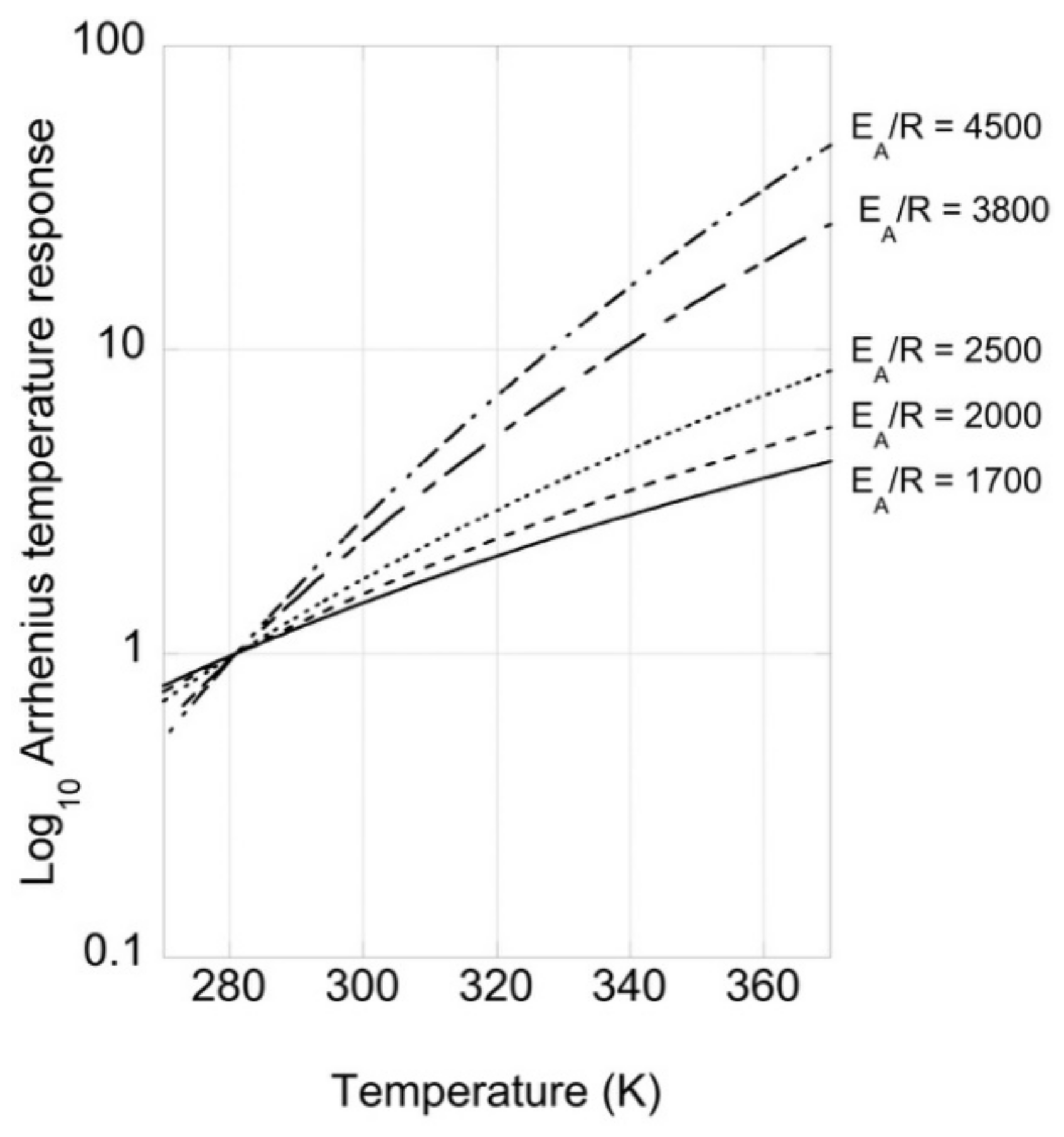
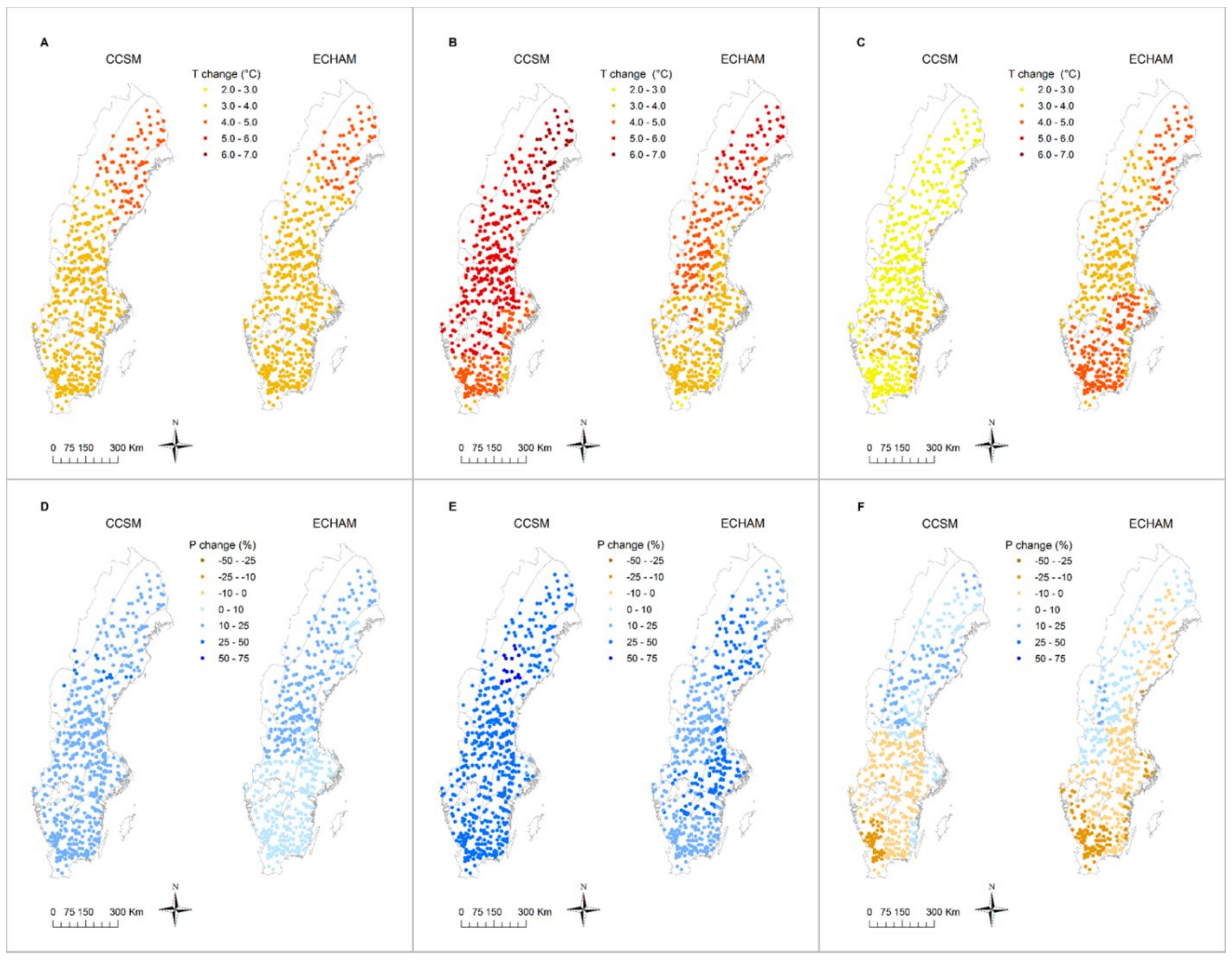
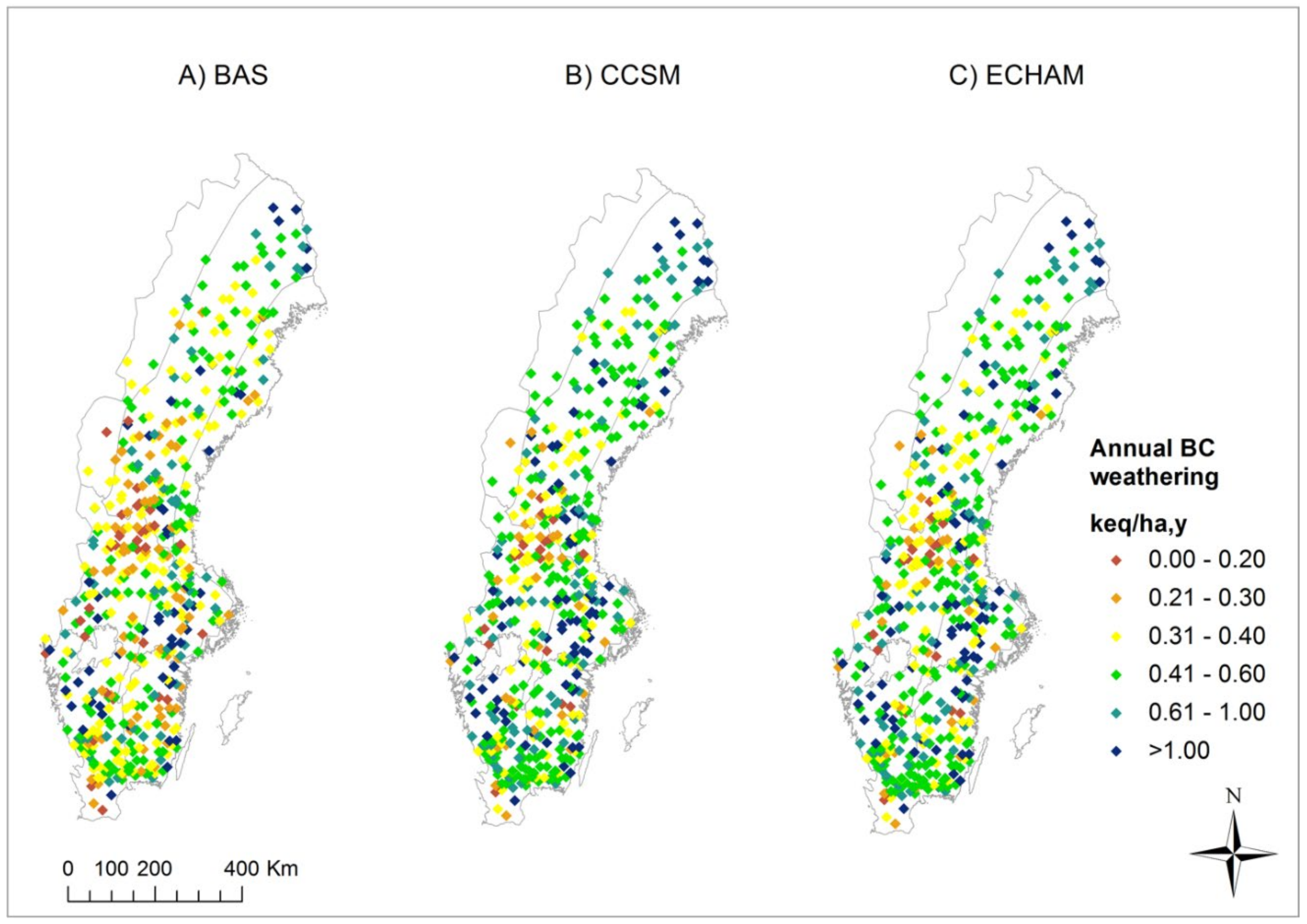


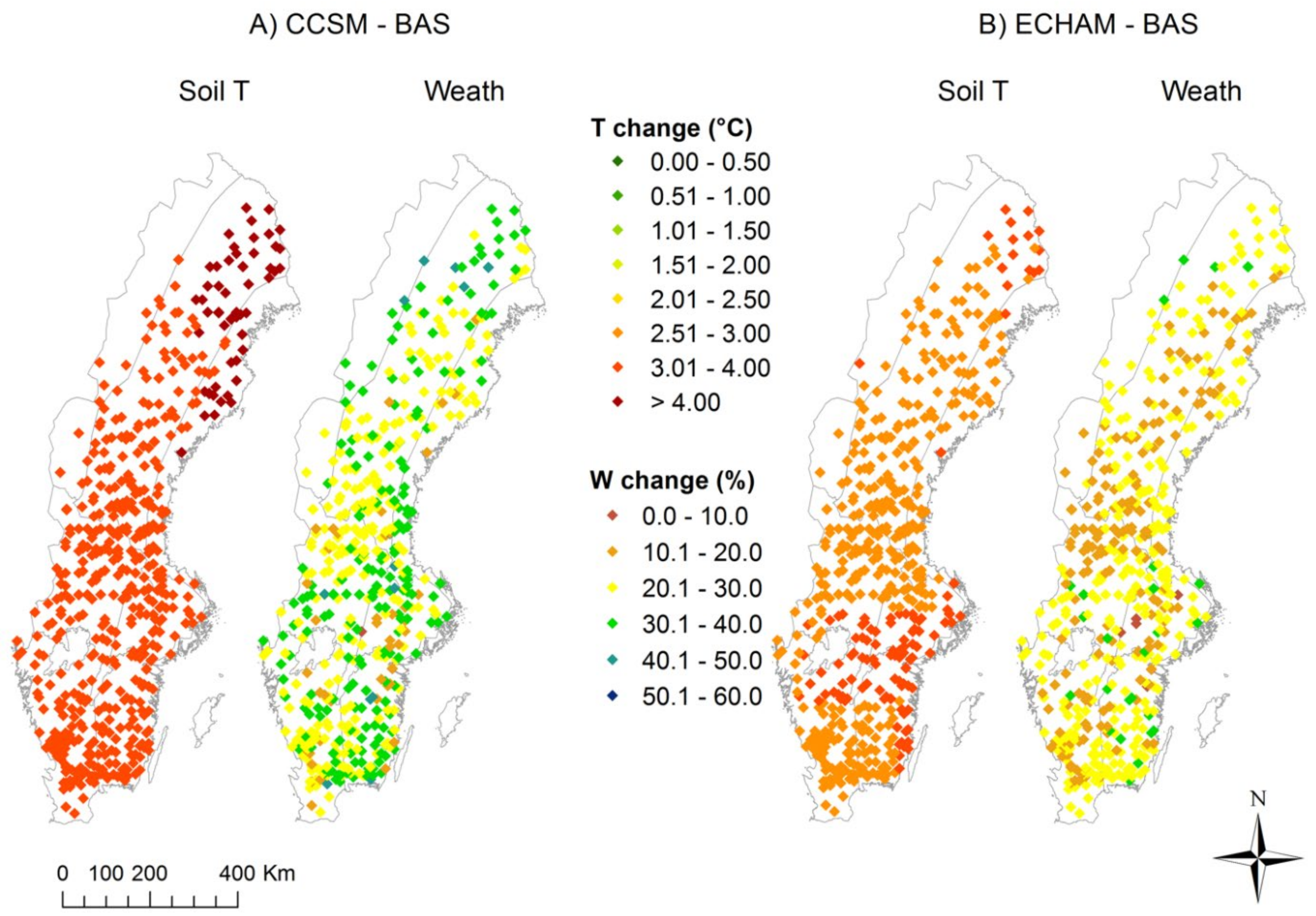

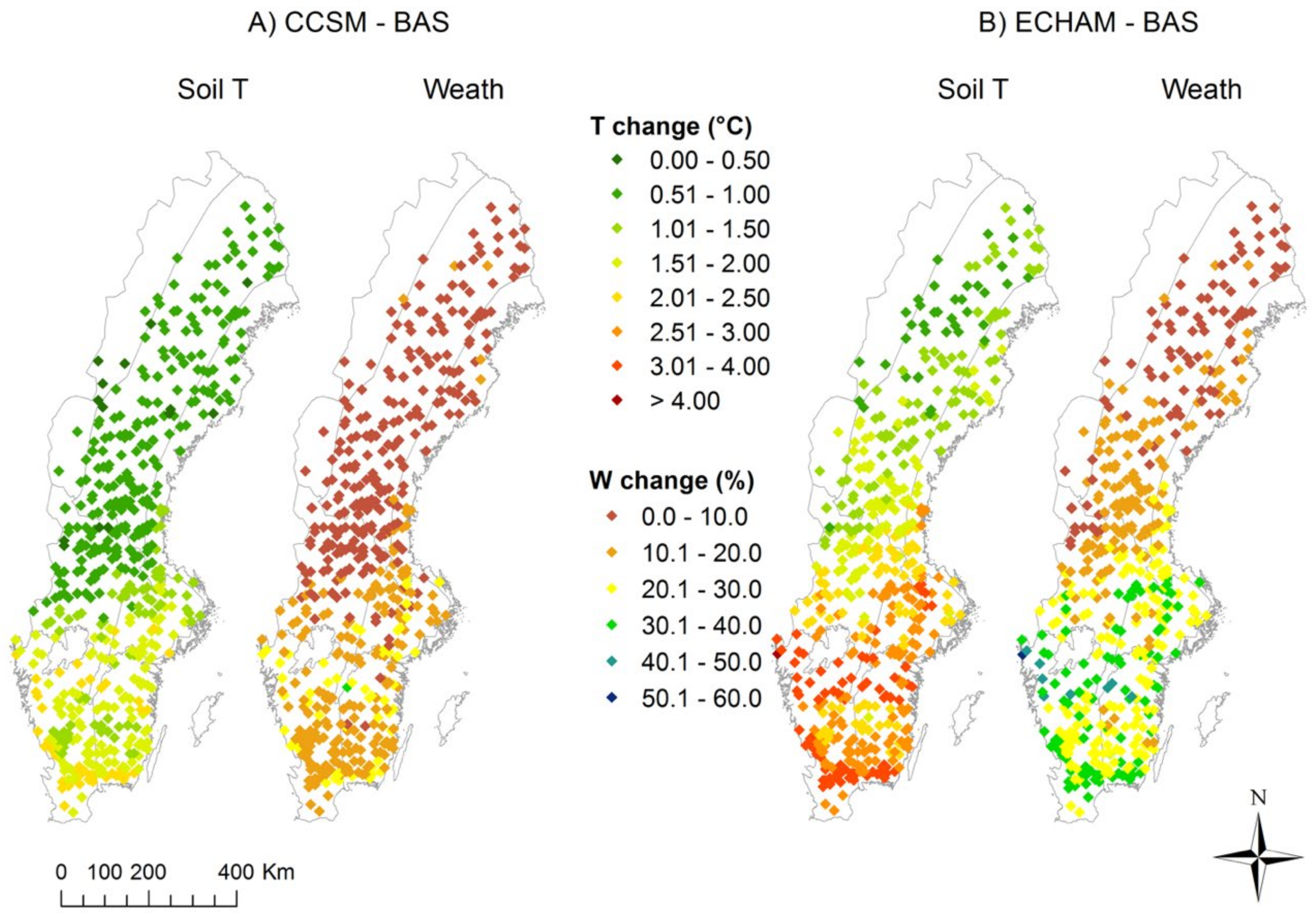
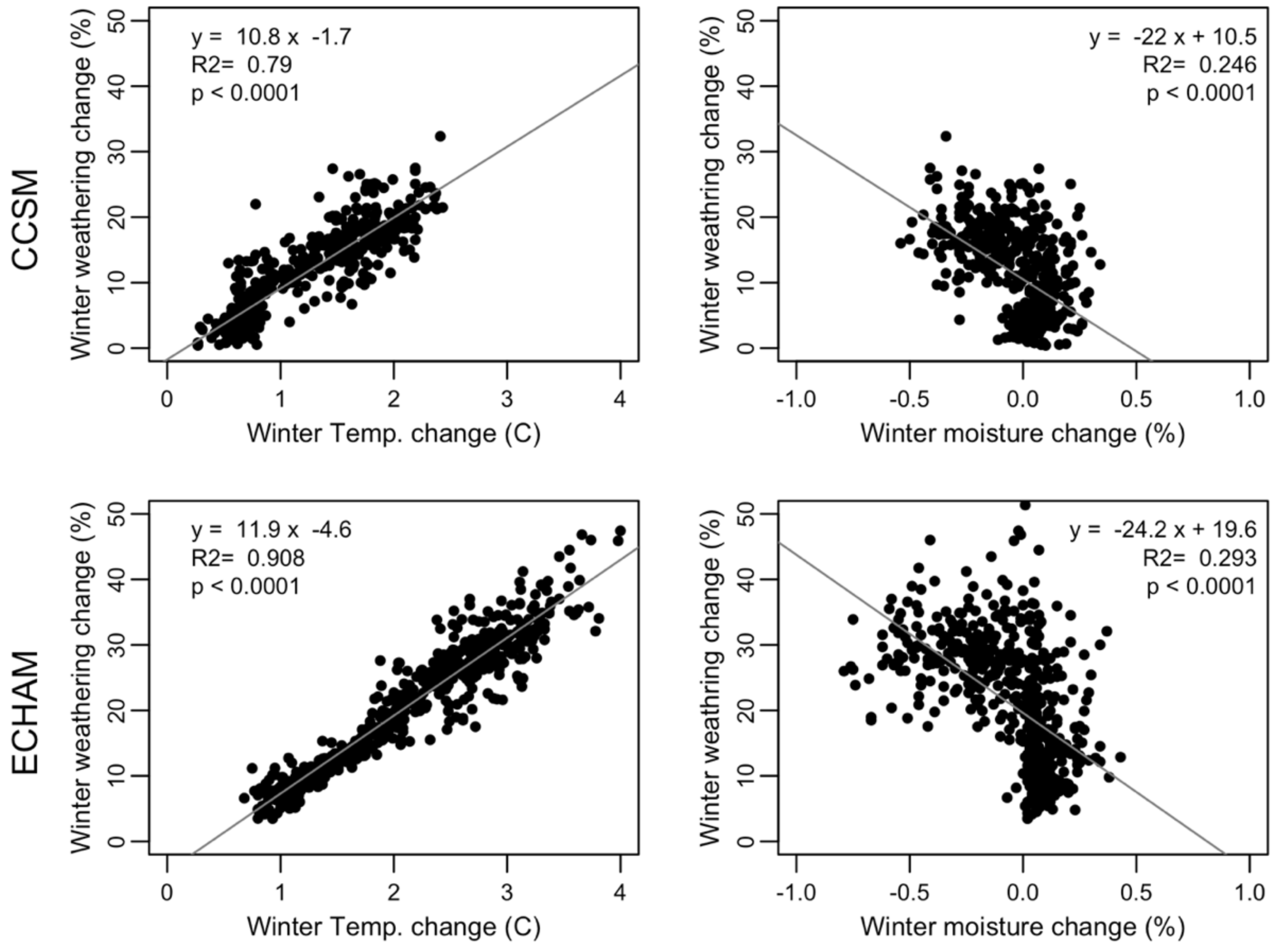
| Annual 1 Weathering Rate without Climate Change (keq·ha−1·year−1) | Annual 2 Weathering Rate with Future Climate According to CCSM (keq·ha−1·year−1) | Annual 2 Weathering Rate with Future Climate According to ECHAM (keq·ha−1·year−1) | |
|---|---|---|---|
| Minimum | 0.05 | 0.05 | 0.05 |
| Maximum | 4.42 | 5.61 | 5.70 |
| Mean | 0.35 | 0.43 | 0.44 |
| Median | 0.24 | 0.30 | 0.29 |
| Std Deviation | 0.40 | 0.48 | 0.49 |
| Skewness | 4.43 | 4.66 | 4.65 |
| Annual | Winter | Summer | ||
|---|---|---|---|---|
| CCSM | ∆Weathering/∆AirTemp | 6.7 ± 1.6 | 2.6 ± 2.1 | 7.3 ± 1.6 |
| ∆Weathering/∆SoilTemp | 9.3 ± 1.8 | 8.9 ± 3.3 | 7.5 ± 1.6 | |
| ECHAM | ∆Weathering/∆AirTemp | 6.6 ± 1.5 | 4.3 ± 2.3 | 7.9 ± 1.7 |
| ∆Weathering/∆SoilTemp | 8.9 ± 1.3 | 9.4 ± 1.8 | 7.7 ± 1.6 |
Publisher’s Note: MDPI stays neutral with regard to jurisdictional claims in published maps and institutional affiliations. |
© 2022 by the authors. Licensee MDPI, Basel, Switzerland. This article is an open access article distributed under the terms and conditions of the Creative Commons Attribution (CC BY) license (https://creativecommons.org/licenses/by/4.0/).
Share and Cite
Belyazid, S.; Akselsson, C.; Zanchi, G. Water Limitation in Forest Soils Regulates the Increase in Weathering Rates under Climate Change. Forests 2022, 13, 310. https://doi.org/10.3390/f13020310
Belyazid S, Akselsson C, Zanchi G. Water Limitation in Forest Soils Regulates the Increase in Weathering Rates under Climate Change. Forests. 2022; 13(2):310. https://doi.org/10.3390/f13020310
Chicago/Turabian StyleBelyazid, Salim, Cecilia Akselsson, and Giuliana Zanchi. 2022. "Water Limitation in Forest Soils Regulates the Increase in Weathering Rates under Climate Change" Forests 13, no. 2: 310. https://doi.org/10.3390/f13020310






